Siete nuovi su WordPress o siete finalmente pronti a passare dall’editor classico all’editor a blocchi?
L’editor a blocchi di WordPress è l’editor predefinito per scrivere contenuti e modificare il sito web. È stato introdotto nel 2019 con il nickname Gutenberg e ha sostituito il vecchio editor classico.
Noi di WPBeginner siamo passati presto dall’editor classico a Gutenberg. I nostri scrittori usano l’editor a blocchi da anni e abbiamo imparato alcuni preziosi trucchi e consigli.
Dopo tanti anni passati a giocare con l’editor a blocchi, abbiamo una profonda conoscenza di come usarlo in modo efficace.
In questo tutorial vi mostreremo come utilizzare l’editor di blocchi di WordPress e come padroneggiarlo per creare post e pagine di blog di grande impatto visivo.
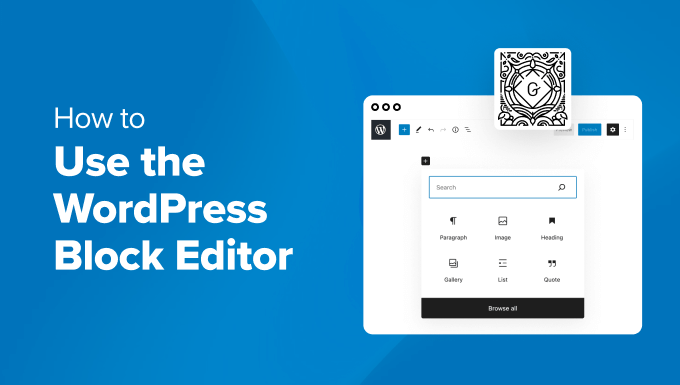
Nota: in questo articolo, chi siamo utilizzerà l’editor a blocchi, progettato per la modifica di pagine e post. Se vi state chiedendo come modificare l’intero sito web con i blocchi, consultate la nostra guida completa alla modifica completa del sito WordPress.
Qual è la differenza tra l’editor a blocchi (Gutenberg) e l’editor classico?
Prima di immergerci nell’editor a blocchi, confrontiamo e comprendiamo le differenze tra l’editor a blocchi di Gutenberg e il vecchio Classic Editor.
Ecco come appariva l’editor classico di WordPress:
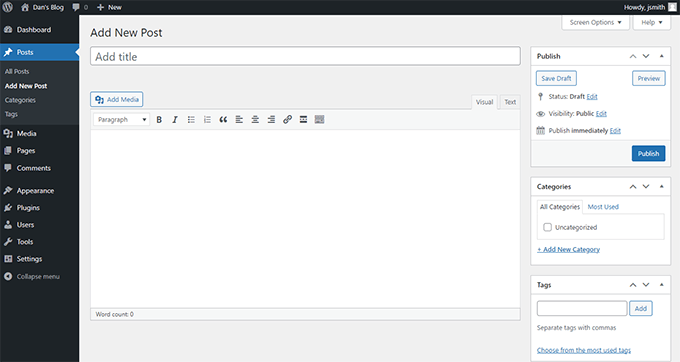
Aveva un editor di testo con alcune opzioni di formattazione di base. La funzionalità e l’aspetto visivo erano piuttosto limitati.
Questo è l’aspetto dell’editor di blocchi in WordPress:
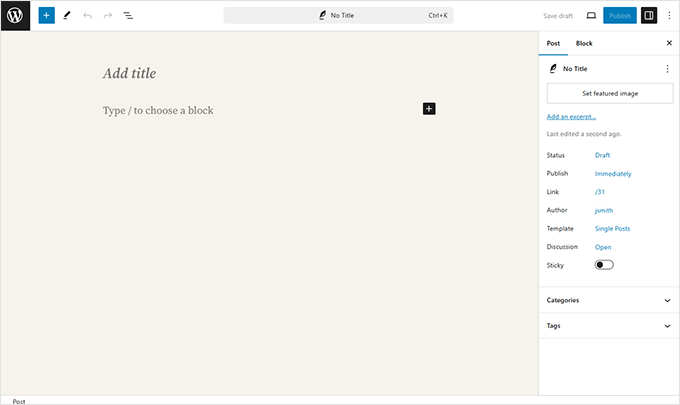
Come potete vedere, si tratta di due editor completamente diversi per la creazione di contenuti in WordPress.
Il vecchio editor classico era un editor di testo con pulsanti di formattazione simili a quelli di Microsoft Word.
Il nuovo editor utilizza un approccio diverso, chiamato ‘Blocchi’ (da qui il nome Editor a blocchi).
I blocchi sono elementi di contenuto che si possono aggiungere alla schermata di modifica per creare layout. Ogni elemento aggiunto al post o alla pagina è un blocco.
Ad esempio, è possibile aggiungere blocchi per paragrafi, immagini, video, gallerie, audio, elenchi e altro ancora. Esistono blocchi per tutti gli elementi di contenuto più comuni e altri possono essere aggiunti dai plugin di WordPress.
In che modo l’editor a blocchi di WordPress è migliore dell’editor classico?
L’editor di blocchi di WordPress offre un modo semplice per aggiungere diversi tipi di contenuti ai post e alle pagine.
Ad esempio, se in precedenza si voleva aggiungere una tabella al contenuto utilizzando il Classic Editor, era necessario un plugin separato per le tabelle.
Con l’editor di blocchi, è possibile aggiungere semplicemente un blocco di tabella, selezionare le colonne e le righe e iniziare ad aggiungere contenuti.
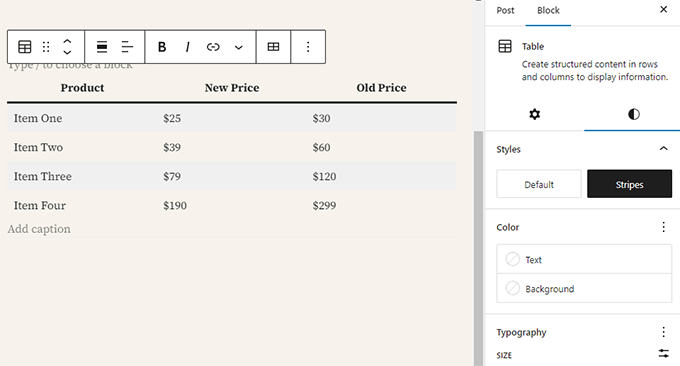
È possibile spostare gli elementi di contenuto in alto e in basso, modificarli come singoli blocchi e creare facilmente contenuti ricchi di contenuti multimediali.
Soprattutto, l’editor di blocchi di WordPress è facile da usare e da imparare.
Questo offre un immenso vantaggio a tutti i principianti di WordPress che stanno avviando il loro primo blog o costruendo un sito web aziendale fai-da-te.
Detto questo, esaminiamo come utilizzare l’editor a blocchi di WordPress per creare grandi contenuti come un professionista.
Ecco cosa tratteremo in questo tutorial su Gutenberg:
- Using Gutenberg – The WordPress Block Editor
- Creating a New Blog Post or Page Using The Block Editor
- How to Add a Block in the Block Editor
- Working With Blocks in the New Editor
- Organizing Blocks in Groups and Columns
- Saving and Reusing Blocks in Gutenberg
- Publishing and Managing Options in Gutenberg Block Editor
- Plugin Settings in Gutenberg
- Adding Some Common Blocks in the Block Editor
- Exploring Other Content Blocks in the Block Editor
- Bonus Tips to Use Gutenberg Like a Pro
- Adding More Blocks to Gutenberg Block Editor in WordPress
- FAQs About Gutenberg – The Block Editor in WordPress
- Video Tutorial
- Bonus Resources
Pronti? Immergiamoci.
Utilizzo di Gutenberg – L’editor a blocchi di WordPress
L’editor a blocchi è stato progettato per essere intuitivo e flessibile. Sebbene abbia un aspetto diverso dal vecchio editor di WordPress, continua a fare tutte le cose che si potevano fare nell’editor classico.
Cominciamo con la copertina delle cose fondamentali che si facevano nell’editor classico e come si fanno nell’editor a blocchi.
Creare un nuovo post o una nuova pagina del blog usando l’editor a blocchi
Inizierete a creare una nuova pagina o un nuovo post per il blog come fareste normalmente. Basta fare clic sul menu Posts ” Add New Post nell’amministrazione di WordPress.
Se si crea una pagina, andare al menu Pagine ” Aggiungi nuovo”.
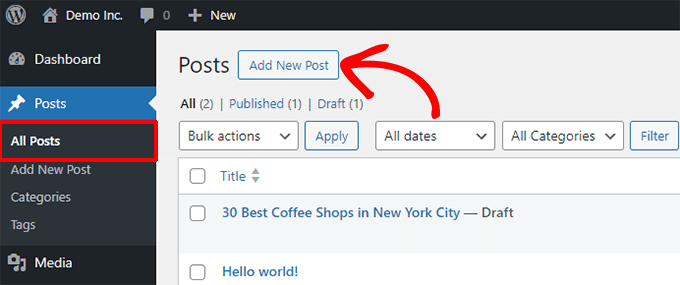
In questo modo si avvia l’editor di blocchi.
Come aggiungere un blocco nell’Editor blocchi
Il primo blocco di ogni post o pagina è il titolo.
È possibile utilizzare il mouse per spostarsi sotto il titolo o premere il tasto Tab sulla tastiera per spostare il cursore verso il basso e iniziare a scrivere.
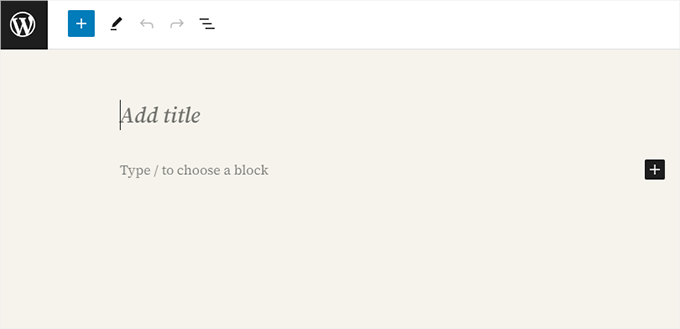
Per impostazione predefinita, il blocco successivo è un blocco Paragrafo. Ciò consente agli utenti di iniziare subito a scrivere.
Tuttavia, se si desidera aggiungere qualcosa di diverso, è possibile fare clic sul pulsante Aggiungi nuovo blocco [+] nell’angolo in alto a sinistra dell’editor, sotto un blocco esistente o a destra di un blocco.
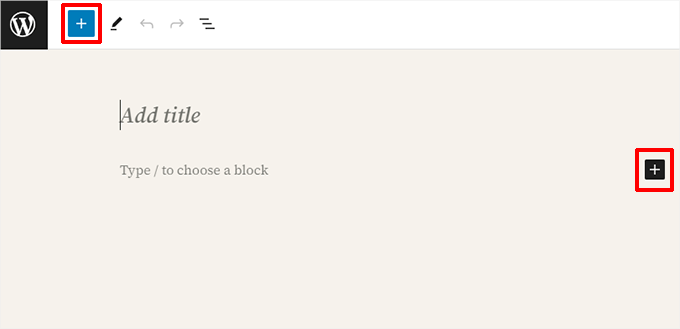
Facendo clic sul pulsante si visualizza il menu Aggiungi blocco, con una barra di ricerca in alto e i blocchi più usati in basso.
È possibile fare clic sulle schede per sfogliare le categorie di blocchi o digitare una parola chiave per cercare rapidamente un blocco specifico.
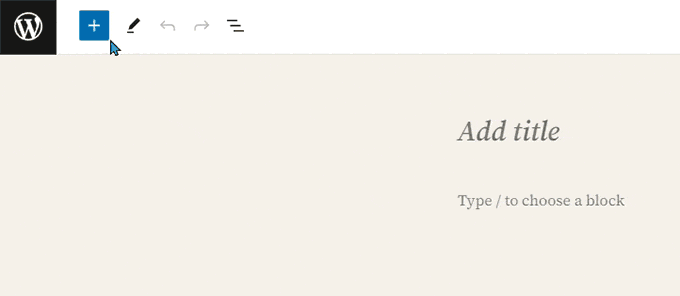
Se non si desidera utilizzare il mouse per fare clic sul pulsante, è possibile utilizzare una scorciatoia da tastiera.
Iniziare digitando / per cercare un blocco e poi inserirlo premendo il tasto Invio sulla tastiera.
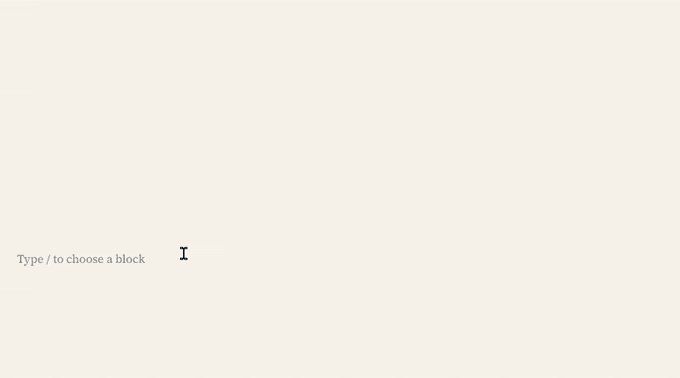
Lavorare con i blocchi nel nuovo editor
Ogni blocco ha una barra degli strumenti in alto. I pulsanti della barra degli strumenti cambiano a seconda del blocco che si sta modificando.
Ad esempio, nella schermata sottostante, stiamo lavorando su un blocco Paragraph che mostra i pulsanti di formattazione di base come l’allineamento del testo, il grassetto, il corsivo, l’inserimento di un link e altre opzioni disponibili nel menu a tre punti.
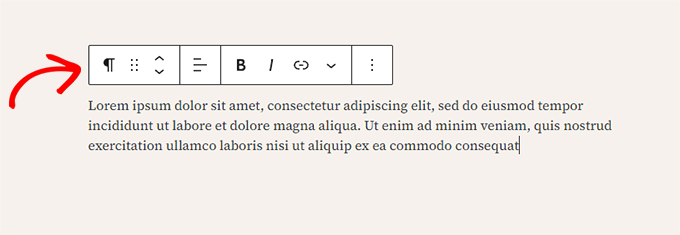
Oltre alla barra degli strumenti, ogni blocco può avere le proprie impostazioni, che appaiono nella colonna destra della schermata di modifica.
Queste impostazioni variano a seconda del blocco che si sta modificando. Ad esempio, il blocco Paragrafo consente di modificare il colore del testo, dello sfondo e dei collegamenti, nonché la tipografia.
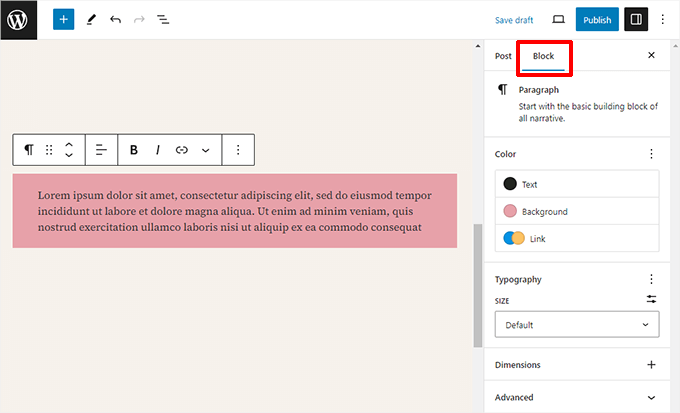
È possibile spostare i blocchi in alto e in basso e riorganizzarli.
Per farlo, è sufficiente fare clic per trascinare o rilasciare o fare clic sui pulsanti su e giù nella barra degli strumenti del blocco.
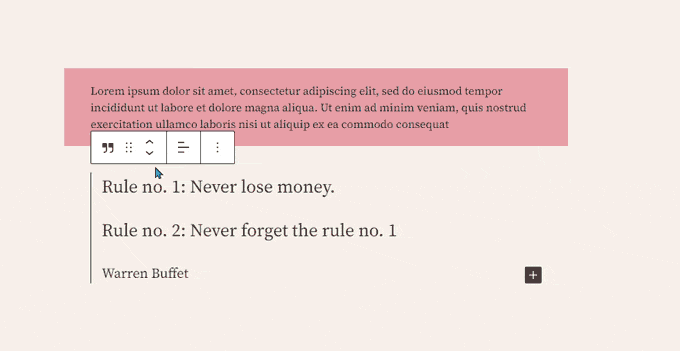
Correlato: Consultate la nostra guida su come rimuovere un blocco in WordPress.
Organizzare i blocchi in gruppi e colonne
L’editor di blocchi è inoltre dotato di strumenti utili per gestire e organizzare i layout dei contenuti.
È possibile selezionare più blocchi facendo clic su di essi e premendo il tasto Maiusc sulla tastiera.
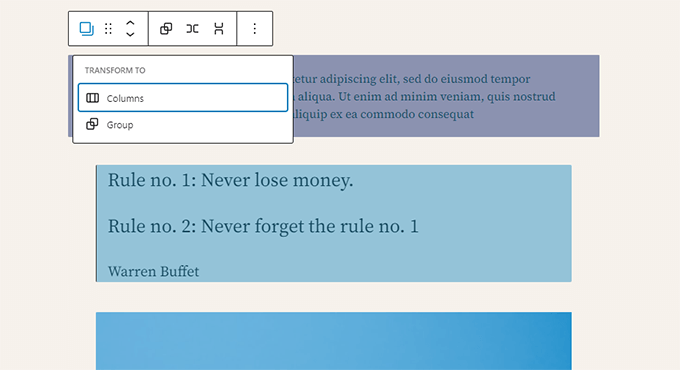
Successivamente, fare clic sul pulsante del tipo di blocco nella barra degli strumenti per trasformare i blocchi selezionati in Gruppi o Colonne.
È quindi possibile applicare gli stili all’intero blocco del gruppo, ad esempio modificando l’allineamento o la spaziatura.
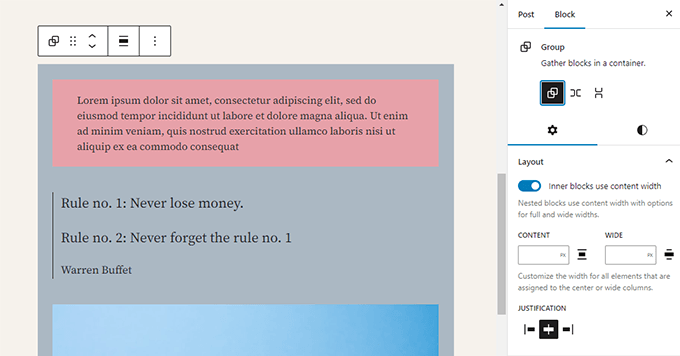
L’editor dei blocchi consente anche di aggiungere un blocco Gruppo o Colonne vuoto.
Dopodiché, è possibile riempirli con altri blocchi.
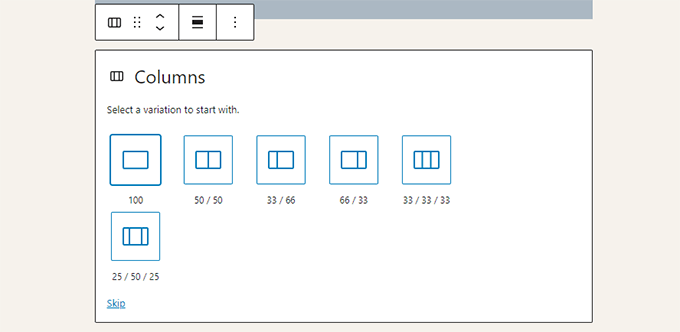
È possibile aggiungere qualsiasi tipo di blocco in ogni colonna, a seconda delle necessità.
Questo permette di creare bellissimi layout per diversi casi d’uso.
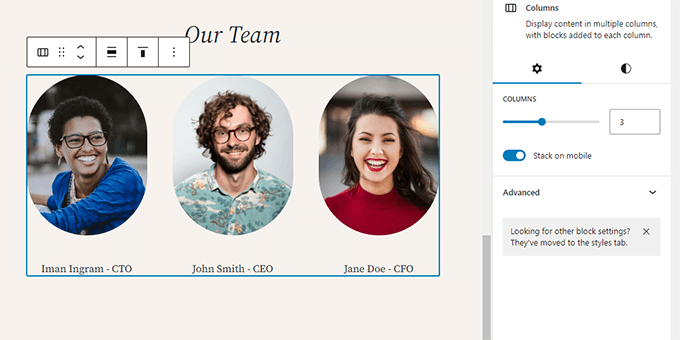
Salvare e riutilizzare i blocchi in Gutenberg
Uno degli aspetti migliori dell’uso dei blocchi è che possono essere salvati e riutilizzati. Questo è particolarmente utile per i proprietari di siti web e i blogger che hanno spesso bisogno di aggiungere snippet di contenuto specifici ai loro articoli o pagine.
È sufficiente fare clic sul pulsante del menu nell’angolo destro della barra degli strumenti di ciascun blocco. Dal menu, selezionare l’opzione “Crea pattern”.
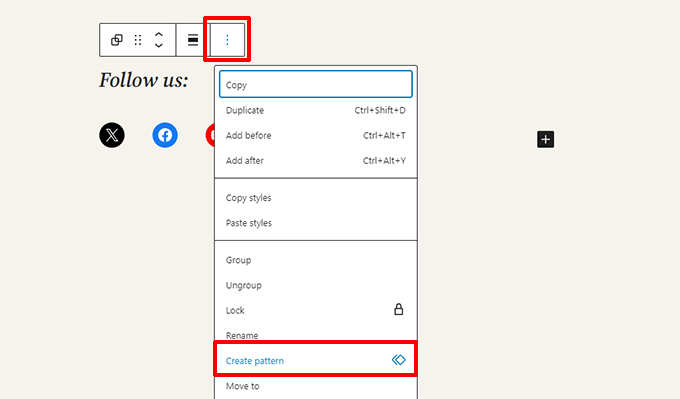
Nota💡: È possibile utilizzare interi gruppi e colonne come blocchi riutilizzabili. Ciò consente di salvare intere sezioni e di utilizzarle quando necessario.
Si aprirà una finestra a comparsa in cui si dovrà fornire un nome a questo pattern. Può essere qualsiasi cosa che aiuti a identificare facilmente quando è necessario riutilizzarlo.
È poi possibile scegliere le categorie. In questo modo è possibile ordinare i modelli in modo organizzato.
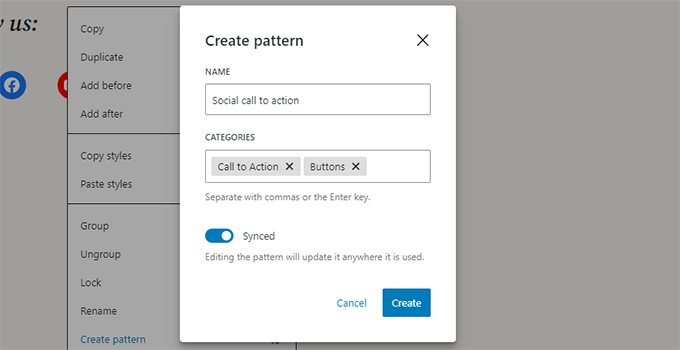
Quindi, fare clic sul pulsante “Crea” per salvare il modello. WordPress salverà il modello con tutti i blocchi al suo interno.
Per riutilizzare il modello, è sufficiente modificare il post o la pagina in cui si desidera aggiungerlo.
Quindi, fare clic sul pulsante [+] Aggiungi blocco o utilizzare la scorciatoia da tastiera / . È possibile trovare il modello digitando il nome che gli è stato assegnato.
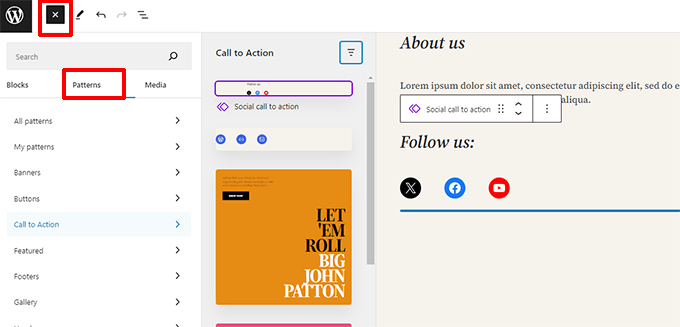
I pattern consentono ai proprietari dei siti di aggiungere facilmente ai loro layout elementi di uso comune, come inviti all’azione, pulsanti per i media, banner e altro ancora.
Il tema o i plugin di WordPress potrebbero essere dotati di pattern propri, oppure è possibile trovare pattern creati da altri nella libreria WordPress Block Patterns.
Se avete bisogno di ulteriore aiuto, abbiamo una guida separata per i principianti su come trovare e utilizzare i pattern dei blocchi WordPress.
Pubblicazione e gestione delle opzioni nell’editor di blocchi di Gutenberg
Ogni post di WordPress contiene molti metadati. Questi includono informazioni come la data di pubblicazione, le categorie e i tag, le immagini in evidenza e altro ancora.
Tutte queste opzioni sono ordinatamente collocate nella colonna di destra della schermata dell’editor.
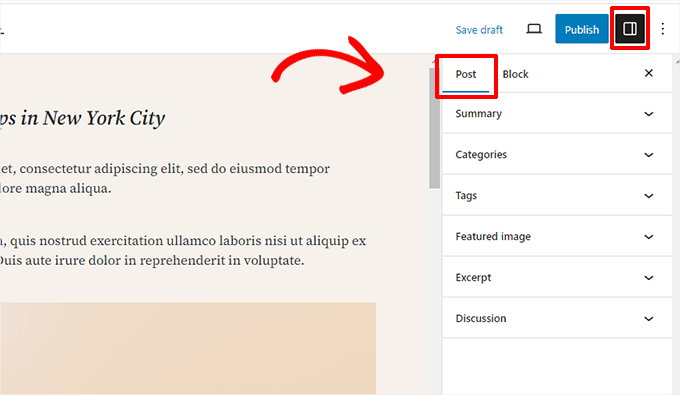
Opzioni dei plugin in Gutenberg
I plugin di WordPress possono sfruttare le API dell’editor di blocchi per integrare le loro impostazioni nella schermata di modifica.
Alcuni plugin popolari sono dotati di blocchi propri.
Ad esempio, WPForms, il miglior plugin per moduli di contatto di WordPress, consente di aggiungere moduli ai contenuti utilizzando un blocco.
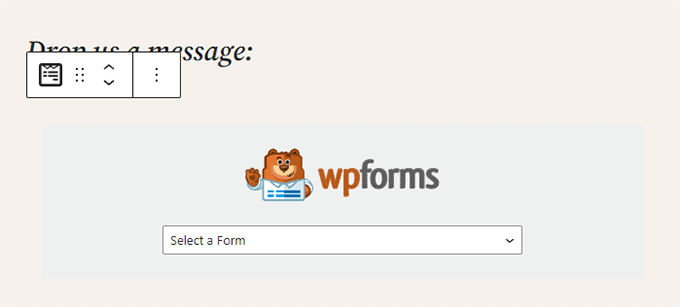
Anche altri plugin di WordPress possono aggiungere le loro impostazioni alla schermata dell’editor di blocchi.
Ad esempio, ecco come All in One SEO per WordPress consente di modificare le impostazioni SEO nella parte inferiore dell’editor di blocco:
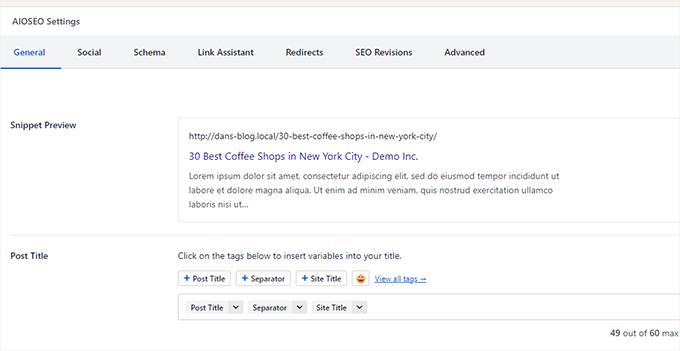
Allo stesso modo, se gestite un negozio online utilizzando WooCommerce, noterete che anche questo ha i suoi blocchi.
Questi blocchi consentono di aggiungere i prodotti a qualsiasi post e pagina di WordPress.
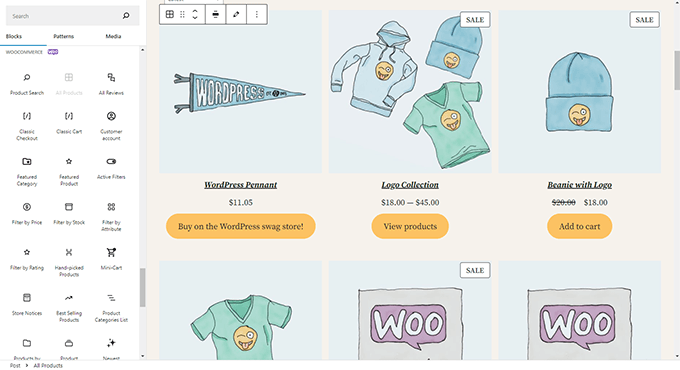
Aggiunta di alcuni blocchi comuni nell’editor di blocchi
L’editor a blocchi può fare tutto ciò che faceva il vecchio Classic Editor.
Tuttavia, le operazioni saranno più rapide ed eleganti di prima. Inoltre, è in grado di fare molto di più, come ad esempio consentire lo stile dei contenuti con una serie di opzioni senza codice.
Ecco alcuni dei blocchi più comuni che si possono utilizzare.
1. Aggiungere un’immagine nell’editor di blocchi di WordPress
Nell’editor di blocchi di WordPress è disponibile un blocco immagine pronto all’uso. È sufficiente aggiungere il blocco e caricare un file immagine o selezionarlo dalla libreria multimediale.
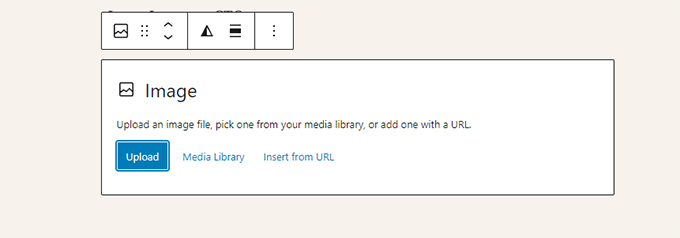
È anche possibile trascinare le immagini dal computer e l’editor creerà automaticamente un blocco immagine.
Una volta aggiunta un’immagine, sarà possibile visualizzare le impostazioni del blocco, dove è possibile aggiungere metadati per l’immagine, come il testo alt, le dimensioni della risoluzione dell’immagine e l’aggiunta di un link all’immagine.
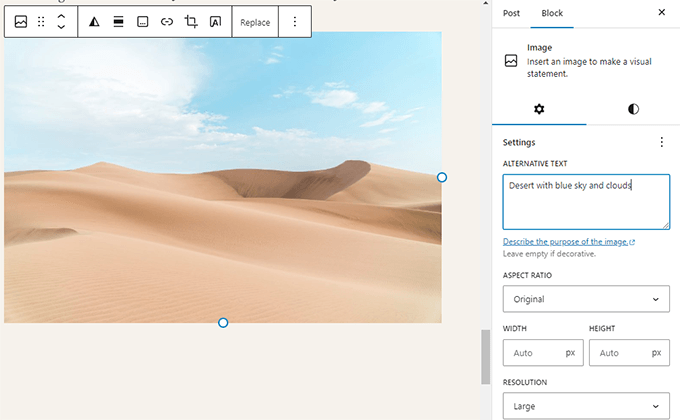
Per maggiori informazioni, date un’occhiata al nostro tutorial su come aggiungere immagini in WordPress.
2. Aggiunta di un collegamento nell’Editor blocchi
L’editor di blocchi è dotato di diversi blocchi in cui è possibile aggiungere testo. Il più usato è il blocco Paragraph, che ha un pulsante di inserimento link nella barra degli strumenti.
Anche tutti gli altri blocchi di testo comunemente utilizzati hanno un pulsante di collegamento nella barra degli strumenti.

È anche possibile inserire un collegamento utilizzando la scorciatoia da tastiera: Command + K per Mac e CTRL + K per Windows.
3. Aggiunta di una galleria di immagini in Gutenberg
Il blocco Galleria funziona come il blocco Immagine. Si aggiunge e poi si caricano o si selezionano i file immagine.
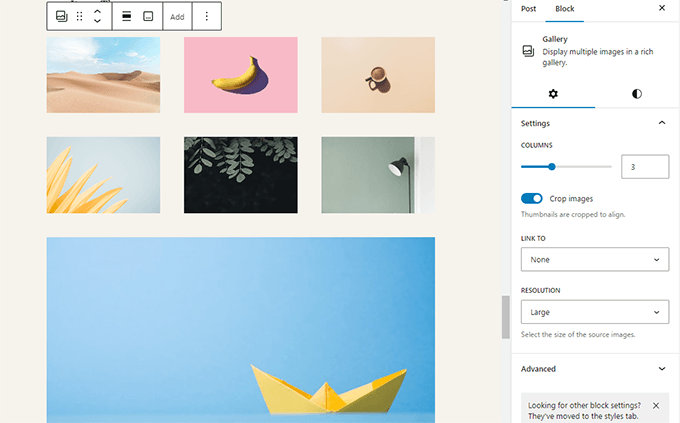
Per maggiori dettagli, consultate la nostra guida sulla creazione di una galleria di immagini in WordPress.
4. Aggiunta di shortcode nei post di WordPress con Gutenberg
Tutti i codici brevi funzioneranno come nell’editor classico. È possibile aggiungerli semplicemente a un blocco Paragrafo o utilizzare il blocco Shortcode.
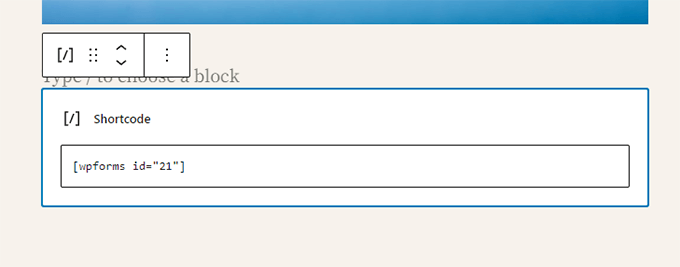
Esplorazione di altri blocchi di contenuto nell’Editor blocchi
L’editor Gutenberg ha promesso di risolvere alcuni annosi problemi di usabilità di WordPress introducendo nuovi blocchi.
Di seguito sono riportati alcuni dei preferiti che riteniamo siano di grande utilità per gli utenti.
1. Aggiungere un’immagine accanto a un testo in WordPress
Molti utenti non riuscivano a inserire un’immagine accanto al testo con il vecchio editor. Ora è possibile farlo con il blocco Media e testo.
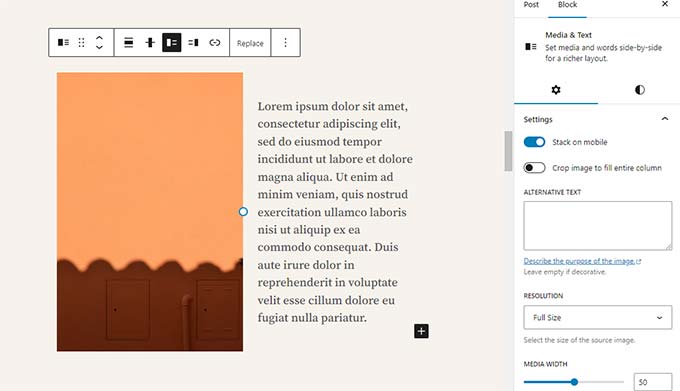
Questo semplice blocco è composto da due blocchi affiancati, che consentono di aggiungere facilmente un’immagine con del testo accanto.
2. Aggiunta di un pulsante nei post e nelle pagine di WordPress
Un’altra seccatura del vecchio editor era l’aggiunta di un pulsante alle pagine o ai post del blog. Si doveva usare un plugin che creava uno shortcode per il pulsante o passare alla modalità HTML e scrivere il codice.
Fortunatamente, Gutenberg ha un blocco Pulsante che permette di aggiungere rapidamente un pulsante a qualsiasi pagina o pubblicazione.
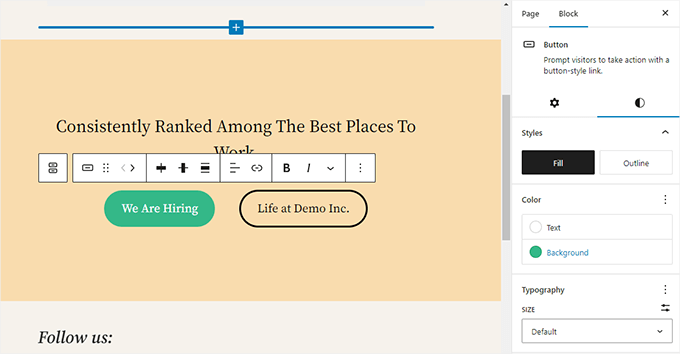
È possibile aggiungere un link per il pulsante, cambiare i colori e altro ancora. Per maggiori dettagli, consultate il nostro articolo su come aggiungere facilmente pulsanti in WordPress.
3. Aggiungere belle immagini di copertina nei post del blog e nelle landing page
Un’altra funzione interessante da provare è il blocco Copertina, che consente di aggiungere immagini di copertina o sfondi colorati ai post e alle pagine.
L’immagine di copertina è un’immagine più ampia, spesso utilizzata per una nuova sezione di una pagina o per l’inizio di una storia. Ha un bell’aspetto e consente di creare layout di contenuti accattivanti.
È sufficiente aggiungere un blocco Cover e caricare l’immagine che si desidera utilizzare. È possibile scegliere un colore di sovrapposizione per la copertina o renderla un’immagine di sfondo fissa per creare un effetto di parallasse quando gli utenti scorrono la pagina.
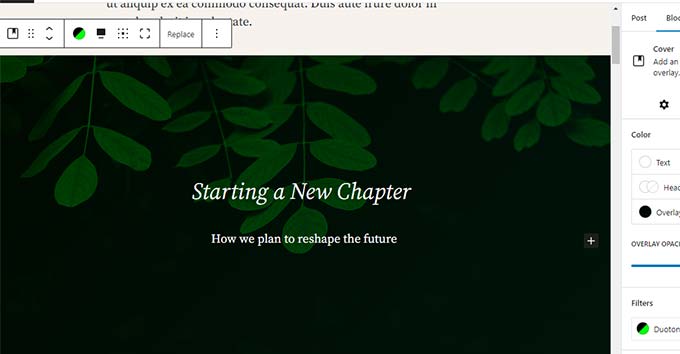
Per maggiori dettagli, consultate il nostro articolo sulla differenza tra immagini di copertina e immagini in primo piano in WordPress.
4. Creare tabelle all’interno degli articoli
L’editor classico non aveva un pulsante per aggiungere tabelle ai post di WordPress. Era necessario utilizzare un plugin o creare una tabella scrivendo CSS e HTML personalizzati.
Ora l’editor a blocchi ha un blocco Tabella predefinito, che rende super facile l’aggiunta di tabelle alle pagine e ai post. È sufficiente aggiungere il blocco e selezionare il numero di colonne e disponi in riga che si desidera inserire.

È ora possibile iniziare ad aggiungere dati ai disponi in riga della tabella. È sempre possibile aggiungere altre righe e colonne, se necessario, e sono disponibili due opzioni di stile di base.
5. Creare contenuti a più colonne
La creazione di contenuti a più colonne era un altro problema che l’editor classico non gestiva affatto.
Fortunatamente, l’editor a blocchi consente di aggiungere un blocco Colonne, che aggiunge due colonne al blocco di paragrafo.
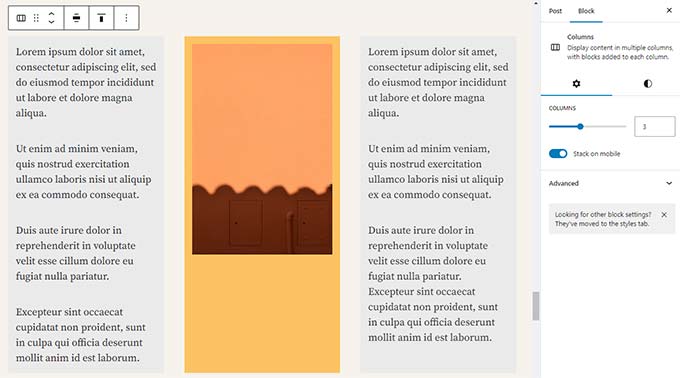
Questo blocco colonna è molto flessibile. È possibile aggiungere fino a 6 colonne in una riga e persino utilizzare altri blocchi all’interno di ciascuna colonna.
Suggerimenti per utilizzare Gutenberg come un professionista
Guardando l’editor a blocchi, ci si può chiedere se si passerà più tempo ad aggiungere e regolare blocchi che a creare contenuti veri e propri.
Beh, l’editor a blocchi è incredibilmente veloce e anche un uso molto elementare per qualche minuto vi permetterà di aggiungere blocchi all’istante senza nemmeno pensarci.
Ben presto vi renderete conto di quanto sarà più veloce il vostro flusso di lavoro con questo approccio.
Ecco alcuni suggerimenti per i power user che vi aiuteranno a lavorare ancora più velocemente con l’editor di blocchi di WordPress.
1. Spostare la barra degli strumenti del blocco in alto
Negli screenshot precedenti si sarà notato che una barra degli strumenti appare in alto in ogni blocco. È possibile spostare questa barra degli strumenti in alto nell’editor.
Per accedere all’opzione ‘Barra degli strumenti in alto’, fare clic sul pulsante con tre puntini nell’angolo in alto a destra della schermata.
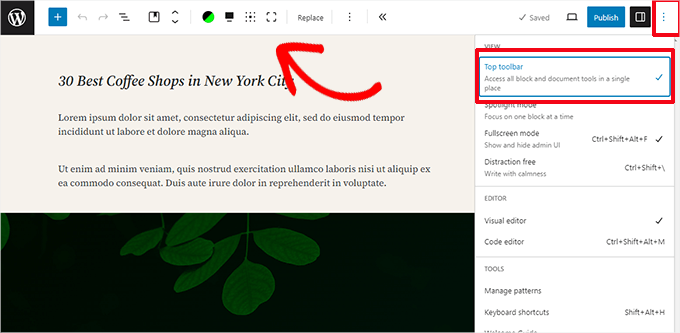
2. Utilizzare le scorciatoie da tastiera
Gutenberg è dotato di diverse comode scorciatoie che renderanno il vostro flusso di lavoro ancora più rapido e semplice. La prima che dovreste iniziare a usare subito è la scorciatoia /.
È sufficiente inserire /, iniziare a digitare e l’editor mostrerà i blocchi corrispondenti che si possono aggiungere immediatamente.
Per ulteriori scorciatoie, fare clic sul menu a tre punti in alto a destra della schermata e selezionare “Scorciatoie da tastiera”.
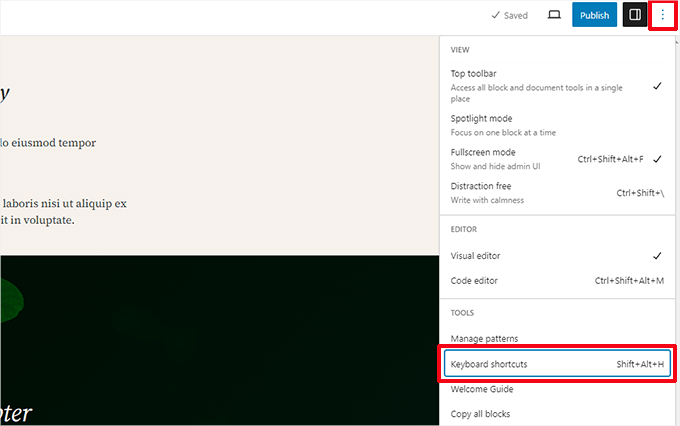
Verrà visualizzato un popup con un elenco di tutti gli scorciatoi da tastiera utilizzabili. L’elenco conterrà scorciatoie diverse per utenti Windows e Mac.
3. Trascinare e rilasciare i media per creare automaticamente i blocchi multimediali
Gutenberg consente di trascina e rilascia i file in qualsiasi punto della schermata, creando automaticamente un blocco per voi.
Ad esempio, è possibile rilasciare una singola immagine o un file video e il blocco verrà creato per voi. In alternativa, si possono rilasciare più file immagine per creare un blocco Galleria.
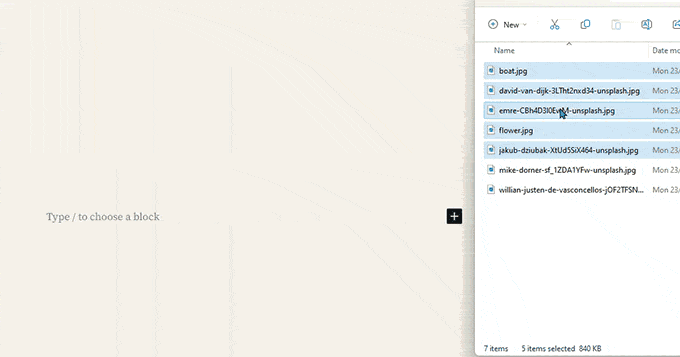
4. Aggiunta di YouTube, Twitter, Vimeo e altri allegati
L’editor a blocchi facilita l’incorporazione di contenuti di terze parti nei contenuti di WordPress. Sono disponibili blocchi per tutti i servizi di terze parti più diffusi.
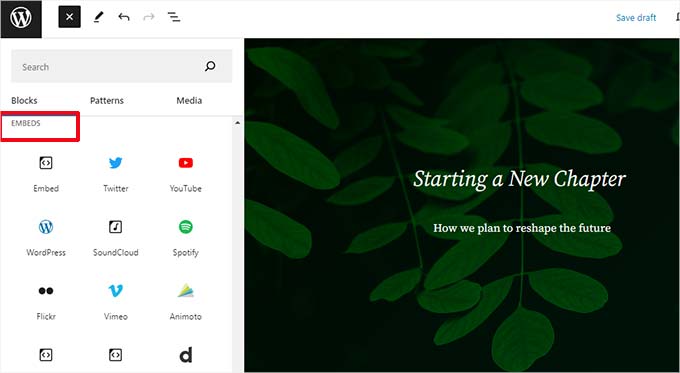
Tuttavia, è sufficiente copiare e incollare l’URL di incorporamento in qualsiasi punto per creare automaticamente un blocco.
Ad esempio, l’aggiunta di un URL di un video di YouTube creerà automaticamente un blocco di incorporamenti di YouTube e visualizzerà il video.
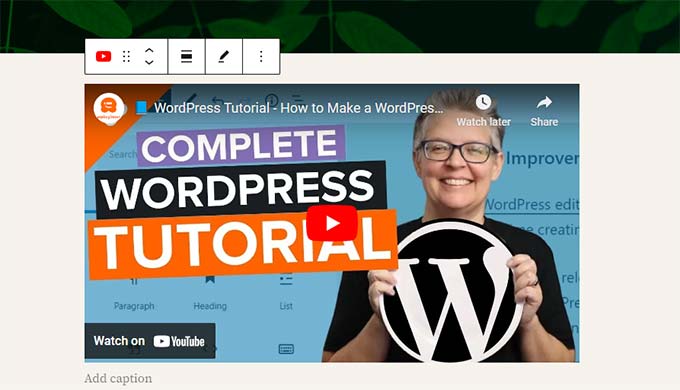
L’opzione predefinita di incorporamento non funziona per gli incorporamenti di Facebook e Instagram, ma esiste una soluzione. Consultate il nostro articolo sull’incorporazione dei post di Facebook e Instagram in WordPress.
Aggiunta di altri blocchi all’editor di blocchi di Gutenberg in WordPress
L’editor a blocchi di WordPress permette agli sviluppatori di creare i propri blocchi. Alcuni ottimi plugin per WordPress offrono pacchetti di blocchi per il nuovo editor.
Eccone alcuni:
1. Blocchi Spectra WordPress Gutenberg

Spectra WordPress Gutenberg Blocks è una libreria di blocchi con molti blocchi avanzati che aiutano ad aggiungere più elementi di design ai contenuti.
Spectra, creato dai creatori del popolare tema Astra per WordPress, vi aiuta a creare bellissimi design senza scrivere alcun codice.
Per ulteriori informazioni, consultate la nostra recensione completa di Spectra.
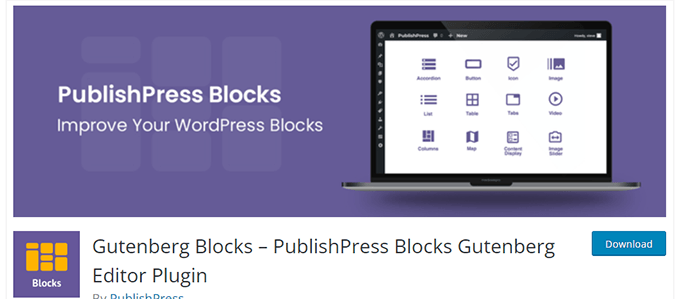
PublishPress Blocks è un’altra potente libreria di blocchi che viene fornita con blocchi aggiuntivi per estendere l’editor di blocchi di Gutenberg.
Include bellissime opzioni di layout, cursori, pulsanti, icone, gallerie di immagini, mappe, schede, testimonianze, fisarmoniche e altro ancora.
3. Impilabili – Blocchi Gutenberg
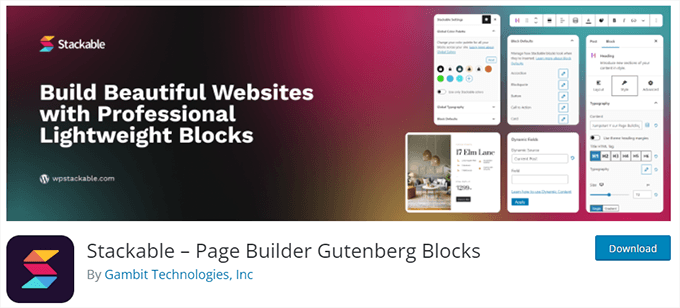
Stackable – Gutenberg Blocks è una raccolta di blocchi Gutenberg dal design accattivante che potete utilizzare sul vostro sito web. Include blocchi per il contenitore, le pubblicazioni, la griglia delle caratteristiche, la fisarmonica, il box immagine, l’elenco delle icone, l’invito all’azione e altro ancora.
Per altre opzioni, consultate il nostro elenco completo dei migliori plugin per WordPress Gutenberg.
Domande frequenti su Gutenberg – L’editor a blocchi di WordPress
Da quando Gutenberg è diventato l’editor predefinito di WordPress, abbiamo ricevuto molte domande su come utilizzarlo. Ecco le risposte ad alcune delle domande più frequenti sull’editor a blocchi.
1. Cosa succede ai miei vecchi post e pagine nell’editor di blocco? Posso ancora modificarli?
L’editor a blocchi non influisce sulle vecchie pubblicazioni e pagine. È ancora possibile modificarli e l’editor a blocchi li aprirà automaticamente in un blocco contenente l’editor classico.
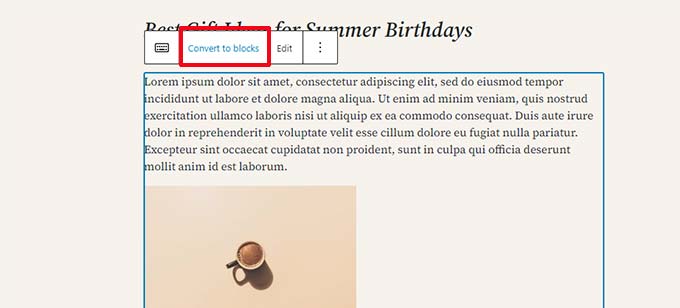
È possibile modificarli all’interno del vecchio editor, oppure convertire gli articoli più vecchi in blocchi e utilizzare l’editor di blocchi.
2. Posso continuare a usare il vecchio editor?
Sì, è possibile continuare a utilizzare il vecchio editor. È sufficiente installare e attivare il plugin Classic Editor.
Dopo l’attivazione, l’editor a blocchi sarà disabilitato e si potrà continuare a usare l’editor classico.
NON SI TRADUCE: l’Editor classico sarà supportato fino al 2025. Per familiarizzare con l’editor a blocchi, iniziare a usarlo ora.
3. Cosa devo fare se l’editor di blocchi non funziona con un plugin o un tema che sto usando?
Il progetto Gutenberg è stato sviluppato a lungo, il che ha dato agli autori di plugin e temi tutto il tempo necessario per testare la compatibilità del loro codice.
Tuttavia, c’è ancora la possibilità che alcuni plugin e temi non funzionino bene con l’editor a blocchi. In questo caso, è possibile installare il plugin Classic Editor, richiedere allo sviluppatore di aggiungere il supporto per Gutenberg o trovare un plugin o un tema alternativo.
4. Come posso approfondire i suggerimenti e i trucchi per Gutenberg?
WPBeginner è il posto migliore per conoscere l’editor a blocchi di WordPress. Siamo il più grande sito di risorse per WordPress su Internet.
Pubblicheremo nuovi articoli e aggiorneremo le nostre vecchie risorse per aiutarvi a padroneggiare l’editor a blocchi.
Nel frattempo, se avete domande, sentitevi liberi di contattarci lasciando un commento o utilizzando il modulo di contatto sul nostro sito web.
5. Problemi con Gutenberg?
Se avete problemi con l’editor a blocchi di WordPress, abbiamo creato una guida rapida alla risoluzione dei problemi che elenca tutti i problemi più comuni dell’editor a blocchi e come correggerli.
Video tutorial
Se non preferite le istruzioni scritte, guardate il nostro video tutorial:
Risorse bonus
Di seguito sono riportate alcune risorse aggiuntive che vi aiuteranno a utilizzare l’editor a blocchi in modo più efficiente:
- Editor a blocchi di WordPress vs. builder di pagine: Qual è la differenza?
- Come creare un blocco personalizzato di WordPress (in modo semplice)
- Come importare/esportare i blocchi di WordPress Gutenberg (2 passaggi)
- Widget e blocchi di WordPress: qual è la differenza? (Spiegato)
- Guida completa per principianti al Full Site Editing di WordPress
- I migliori temi a blocchi per il Full Site Editing in WordPress
- Suggerimenti per padroneggiare l’editor di contenuti di WordPress
Se questo articolo vi è piaciuto, iscrivetevi al nostro canale YouTube per le esercitazioni video su WordPress. Potete trovarci anche su Twitter e Facebook.





jeff
I inserted a hyperlink on a phrase and I want to change the font color for that phrase. how do I do that? please help
WPBeginner Support
If only for that specific phrase, you would need to edit the text as HMTL to add styling to that phrase at the moment
Admin
Anne
Hello!
I created a column block with 3 columns. Added content and everything was distributed across the page width equally. Then I added a 4th column and now the column block no longer distributes across the entire page width. It’s seems like it has “squooshed” (sorry, can’t think of a better word right now), all 4 columns and shrunk the info as well. I tried various alignments for each individual column and it still would not spread the entire block back out. Hope this makes sense and hope you can help. Thanks!!
WPBeginner Support
It sounds like what you added to your largest column has a minimum width that is not allowing the content to adjust which would be the root of your problem.
Admin
Mark Watts
I’m struggling with the Gutenberg block editor. Heres a couple of questions but there will surely be many more to come.
How do I add a pdf document so it opens when I click a link? Used to create and highlight the link text then select “add media” and all worked fine.
When I try to add a link from within the paragraph block I no longer see a list of possible pages and posts so that I can chose. How do I get this list.
WPBeginner Support
You would manually need to take the link from the document in your media library unless you wanted to embed it. In the paragraph block, there is the link button which is third from the right, as you type into it the dropdown should appear
Admin
Tuan
This upgrade so stupid. I spent more time to write. Haiz
WPBeginner Support
Learning a new interface can certainly be troublesome but as the interface improves it should slowly become better to use
Admin
Jennifer
I’ve searched and can’t find an applicable answer to my issue, so I’m hoping you can help me.
I upgraded to the new block system for our website this past week. I need to find and copy the url for one of our buttons (it’s a redirect to PayPal), but I can’t find the url anywhere.
There’s no “edit button” when I hover over the button in the block. I checked the html and couldn’t find it there, either – the only thing I could see were the image files for the button itself.
Clicking on the button live still redirects correctly, so I know the link is working – I just can’t find it.
Any advice?
Thanks!
Jennifer
WPBeginner Support
When you select the block there should be the block settings on the right-hand side where you would find the link settings for where the button links to if it was transferred as an image. If it is a button block then there should be the url beneath the button where you can edit it.
Admin
Franklyn Fosu
Please help me resolve the “Update failed” issue when trying to publish my articles using the Gutenberg.
WPBeginner Support
To start, you would want to go through the steps in our troubleshooting guide: https://www.wpbeginner.com/beginners-guide/beginners-guide-to-troubleshooting-wordpress-errors-step-by-step/
For a temporary workaround, you could also enable the classic editor plugin and reach out to the support for Gutenberg.
Admin
Carlos Goncalves
How to use the new advanced Css option. I Tried to put some code there, but It´s not run.
WPBeginner Support
That is for adding a class to the object, you would want to take a look at our explanation of CSS to understand classes better: https://www.wpbeginner.com/glossary/css/
Admin
Candi Clark
On the top right of my block edit page, it doesn’t say publish. The button says update. When I click that button it says page has updated but when I go take a look at it on my website it hasn’t changed. Did something not upgrade correctly to have that button not say publish?
WPBeginner Support
You may want to check any caching that you have on your site that could be causing the problem.
Admin
Jim Kielbaso
How do I go back to the old version? There was nothing wrong with it, and this version does not add anything. In fact, it makes it MUCH more confusing. It is NOT user-friendly, and it has been very frustrating. Upgrades should only be made to improve something, not just for the sake of changing.
WPBeginner Support
The new editor was created to help those new to WordPress have less of a barrier to entry. For those who prefer the old editor, there is the Classic Editor plugin and we explain that plugin in our article here: https://www.wpbeginner.com/plugins/how-to-disable-gutenberg-and-keep-the-classic-editor-in-wordpress/
Admin
Sufyan Shaikh
Good article.
WPBeginner Support
Thank you
Admin
AlannaMH
How do I change the font of text in blocks?
WPBeginner Support
For setting up your site’s font, you would want to take a look at our article here: https://www.wpbeginner.com/wp-themes/how-to-add-custom-fonts-in-wordpress/
Admin
Viktor
Time consuming, if you go to WP you will see very negative comments
For me the solution was to activate a plugin called “Disable Gutenberg”
I understand there´s a learning curve…but I pass..sorry
WPBeginner Support
If you’re not ready to use the Gutenberg editor then using a plugin like that is certainly understandable.
Admin
Frank Kinghorn
I am a complete novice in website writing and decided to use WP because it seemed to have good support. At that time I did not realise WPbeginner existed but wow! now that I’ve found various guides from wpbeginner I am convinced that I made the right choice. Specifically, this guide on the new editor is fantastic. Even its existence helped me out of a deep hole: I have installed WP on my pc so I can play with it before starting my first real website but got stumped because when I got to the stage of trying to edit a page there was no sign of the editor shown in the “Getting Started with WordPress” guide by iThemes. I spent hours trying to see if my download to my pc was corrupted or if I was missing something simple – now I know the classic editor has been replaced! Sorry for the long post but a real thank you for this guide and the several other documents I have found from WPbeginner.
WPBeginner Support
Thank you, glad our site and articles could help you get up and running with WordPress
Admin
vivek
everytime i try to publish ..all i get is Auto Draft.
cant understand what is going on
WPBeginner Support
For a starting point, you may want to go through our troubleshooting article here: https://www.wpbeginner.com/beginners-guide/beginners-guide-to-troubleshooting-wordpress-errors-step-by-step/
Admin
Aaron P
Thanks for a great article! This really helped me make the transition. I was hesitant to switch, but now that I’ve played around for a while I like the new block editor.
WPBeginner Support
You’re welcome, glad our article could ease the transition
Admin
Matthew Pan
Hi, thanks for this, was really helpful.
May I ask, for adding a button block, I’m currently unable to add one such that it opens up in a new tab. There used to be an easy checkbox for this. Do you know how to do so?
2. Adding a button in WordPress posts and pages
Thanks!
WPBeginner Support
When adding a link you should have an option with three dots that you can click to have the open in new tab option again.
There is a button block you can use to add a button to your posts and pages
Admin
sally
How do I use Grammarly app with this new editor, because I cannot see Grammarly popping down there to correct my mistakes or even show me my mistakes? Thank you.
WPBeginner Support
Once you reach the second line in a paragraph block the Grammarly check should appear in the bottom corner. If it’s not appearing you could reach out to Grammarly’s support and they should be able to help ensure it appears correctly in your editor.
Admin
Linn
Hi, as a brandnew beginner, I took two courses on WordPress 5 by Morten on Lynd. Gutenberg is easy to use. However, I still don’t know how to build header and footer with Gutenberg. I need a full width color background, onto which I add several buttons such as “about,” “services,” “products,” etc. Can you help?
WPBeginner Support
Headers and footers styling is normally handled from your theme, you would either need knowledge of HTML, CSS, and PHP or you could take a look at our article here: https://www.wpbeginner.com/wp-themes/how-to-easily-create-a-custom-wordpress-theme/
Admin
Ima
Do you know if they have been able to fix the scrolling issue in the block editor? It is really annoying that you can’t scroll to the bottom of the block section without having to go to the Settings section and scroll there. I have googled and googled some more, and I am not finding a solution. Thanks so much!
WPBeginner Support
Unless I hear otherwise, the error shouldn’t be an issue but you could reach out to the WordPress.org support for if the specific error you are running into was resolved.
Admin
Steve Briese
Come on, folks. These are not the people who created WordPress. These are the people who are kind enough to help you adjust to the blocks. How many times do they need to tell you to install the Classic Editor plugin if you don’t like blocks? I don’t know if I like blocks or not, but I feel more confident in testing them after reading this introduction. Thank You!
WPBeginner Support
Glad our article could help
Admin
Sandeep
Hi, after I installed WordPress 5.1 , using Gutenberg if go to write text, on top of first word one line will come . I am not getting what’s issue. Can tell how to solve this
WPBeginner Support
Have you tried disabling all of your plugins to see if this could be a plugin specific issue?
Admin
Denny Gibson
I’ve found no way to wrap text around images. Am I missing something or is this not as popular as I thought?
WPBeginner Support
You would want to use the Media&Text block to have your text wrap with the block editor
Admin
Tom Schulte
Is there a way to still code in html in the block editor?
I ask this because the block editor inserted an extra wide space between 2 lines which I did not want. I could and did use the classic editor’s text option to get rid of the extra space.
WPBeginner Support
Yes, you can use the ellipses in the top right to swap to HTML or you could use a classic block if you only wanted to edit a specific section in HTML
Admin
Rick Swift
I grudgingly started using this new block mentality, and I wasn’t happy about it. I am glad I found your article, though, because it has made navigating this new concept much easier.
Wondering if anyone has had this experience though. While adding tags to my Document, I will add the tags, hit enter and the little box doesn’t expand at all. I have NO idea how to see my tags that I have entered.
I use WooThemes – Canvas
Very frustrating experience right now.
WPBeginner Support
If you have not already, you may want to try disabling your plugins and/or swapping themes to see if it is a conflict with one of those that is preventing the auto-expanding tag section from displaying properly.
Admin
Charles
Maybe one day I will figure out how to use this, but at the moment it seems impossible. I have used over a dozen word processors, and various web editors, but that experience is not helping me now.
I would like to indent a number of paragraphs. Sounds simple, but I have not found a way to do it. What is the use of having a paragraph block that can’t indent?
Last time I gave up on putting in a table and went back to editing HTML in the old system.
WPBeginner Support
While the paragraph block does not have an indent option at the moment, should you use the block editor again you could add an indent using the Classic block
Admin
Craig Wallace
So the concept of allocating a Template to a new page is gone?
As far as I can see, when you are making a new page ‘from blocks’ there is not way to select a template that you may have constructed in the old way? (i.e. the drop down for templates is no where to be seen).
WPBeginner Support
You would want to check under page attributes to set the template for a page if your current theme has templates.
Admin
Nina Haeringer
How do you increase font size in a list block? I have looked everywhere. I am new to WordPress and find it not very user friendly but I’m trying to get the hang of it. I need to be able to increase list block font size. Please help.
WPBeginner Support
You would need to manually add CSS to change that font size or you could use a plugin such as CSS Hero:
https://www.wpbeginner.com/plugins/css-hero-review-wordpress-design-customization-made-easy/
For how to find the CSS you need to change you can use inspect element which we explain how to use in our article here: https://www.wpbeginner.com/wp-tutorials/basics-of-inspect-element-with-your-wordpress-site/
Admin
Mario Garcia
I just installed the new Word Press (blocks) and I am having trouble because Ido the title block fine, then whatever I type for the second block appears duplicated when I do the preview: I see that block under the title TWICE in the post. What am I doing wrong?
WPBeginner Support
You may want to check with your theme’s support to ensure that this is not a style of your specific theme
Admin
Ericka
I’m trying to navigate the new Block editor. I’m simply looking for the “read more” button that you use to be able to simply click a button on the Classic editor and it would place the “read more” button to divide the text on the home page.
WPBeginner Support
It was renamed into the More block
Admin
TEGA PERKINS ODJEGBA
How do I increase the size of my block, I have read through the guide several times. You did not address that.
If I want to increase the writings in a block, how do I do that, and is it possible to join two block?
WPBeginner Support
It would depend on what you’re trying to change. You can copy and paste the content then remove the block you moved the content from but there is not a simple merge button at the moment. If you’re looking for the font size, that is normally governed by your theme’s CSS
Admin
Kelsey
I can’t figure out how to do a “read more” option so that the first few sentences of a blog show up as a preview on the main blog page. Any insight? Also is there a way to change the colour of the font of hyperlink? Thanks!!
WPBeginner Support
You would want to add the More block to use the read more function. For the hyperlink color, you would want to modify the CSS, you can test the color changes you want to make using inspect element then copy the custom CSS to your Appearance>Customize>Additional CSS section: https://www.wpbeginner.com/wp-tutorials/basics-of-inspect-element-with-your-wordpress-site/
Admin
Vicky
Great introduction, thank you!
WPBeginner Support
You’re welcome
Admin
Curry
Under the classic edit I could place a picture within a paragraph and keep everything inside the margins. I have not been able to do it with Guttenberg. I have followed the instructions re: media-paragraph block and it appears to work fine. But when I switch to preview it places the picture before the paragraph. If I simple add a new bloick I can only place the picture left or right but then it is outside the margins of the script – which does not look good. Very frustrating. Looking for help.
WPBeginner Support
Your browser window may not be wide enough for the text to not automatically be placed below, you would want to reach out to the support for your specific theme to see if the styling needs to be updated for it to work with the block editor.
Admin
Curry
I have followed your instructions for placing an image next to text in the new Gutenberg Editor. It looks fine – until I click on Preview. It then shows up as a large picture prior to the text. I have been unable to get it to transfer into Preview correctly
WPBeginner Support
If you are on mobile it may be stacking the text and image due to the advanced settings for the image in that block.
Admin
Debra Oakland
Since this new format will no longer size my Fotolia cover photos as they wereiin the old editor, (I need them wide and narrow) I chose The Cover Block which widened and narrowed the photo. I put the title in the center of the cover block. The article says no title (obviously) so I need to change the permalink. I can’t delete the uncategorized and the number after it to put the proper permalink in. Just trying to work things out without going back to the old editor. Can’t find any info on changing this permalink. Hoping this makes sense. Thank you for this tutorial, it’s very helpful.
WPBeginner Support
For editing your image’s size you may want to use an image editor such as one in our article: https://www.wpbeginner.com/showcase/tools-to-create-better-images-for-your-blog-posts/
If you have your category in your permalink then you would need to change your category and manually save your draft for the permalink to update to the new category.
Admin
Silke
Hi, how do I assign a menu to the footer bar wo it appearing underneath as well? Atm I create a custom footer menu. By assigning it to ‘Footer menu’ in Dashboard/Appearance/Menus it automatically appears on the page. If I now assign it to the footer bar I’ll have the menu twice.
Here’s the problem: If I DON’t assign ‘footer menu’ to my custom footer menu it’s not available in the footer bar editor.
WPBeginner Support
Your theme may have a specific setting that could be causing an issue. If you reach out to your specific theme’s support and let them know about it not appearing/appearing twice
Admin
Mark Braunstein
I don’t have time to learn a new editor. Nor do I want to. Change is not always good. I have lost days of work. Thanks!
If it was better, then Microsoft Word would operate like Gutenberg. Really doesn’t matter. It needs to operate in a way we all know. Not some fancy theoretical method. Productivity is key, and if we cannot make it work, we have lost productivity. We dont need a better mousetrap, simply one that works. I guess I have to find another site platform.
I and I guess many others find it counter intuitive. There was once a button to use the Classic editor but now I cannot find it. I don’t want to keep adding plugins to my sight. They are fraught with bugs.
WPBeginner Support
We are not in control of the development of WordPress, we try to help people understand how to use WordPress. Not all plugins are fraught with bugs, you may want to take a look at the plugin here: https://www.wpbeginner.com/plugins/how-to-disable-gutenberg-and-keep-the-classic-editor-in-wordpress/
Admin
Cheryll
I have been so confused and it already feels time consuming trying to learn this new way if doing things. As someone who is not tech savvy but really enjoys diy, this has set me back. Your article has definitely been helpful though so a huge thank you!
WPBeginner Support
Glad our guide could help, if you wanted to revert to the old editor for the time being you could also take a look at: https://www.wpbeginner.com/plugins/how-to-disable-gutenberg-and-keep-the-classic-editor-in-wordpress/
Admin
Virginia
I find this Gutenberg time-consuming and not worth the effort, yet I feel I must make it work.
However, I am not seeing those marks at the left of the blocks, and can’t figure out how to move them.
Also, when I insert a pull quote it messes up the spacing of the other blocks and I can’t figure out how to fix that either.
WPBeginner Support
For the quote, you may want to check with your theme’s support about the styling. For the icons on the left, they should appear when you hover your mouse near the block’s left side as long as you have more than one block. You may want to expand your browser window to see if that allows you to see them.
Admin
Virginia
Thank you. I figured out what the issue is. I have to enable Jet Pack for the icons to show. The weird thing is, I have to enable it for each post individually. I still hate this “improvement”.
Kevin
Thanks for the helpful post. I haven’t tried WP Blocks yet, but it looks like it could be useful. I’ve been using Elementor for the past eight months and Blocks seems similar.
Can I make templates w/ blocks so that I can use the same layout on many pages/posts?
Thanks again.
WPBeginner Support
The block editor does not have that level of customization at the moment, the closest to what you’re asking would be a reusable block: https://www.wpbeginner.com/beginners-guide/how-to-create-a-reusable-block-in-wordpress/
Admin
Mike How
Hi,
I upgraded to WordPress 5 and my updates page tells me I have the latest version. I have no gutenburg block editor, however. I see that the classic editor is activated on my list of plug ins. I’d like to try the block editor, but don’t know if it’s installed as I didn’t reactivate the classic editor after the update. What should I do? Just deactivate the classic editor? or use the prompt to re install WordPress 5? or something else? Goes without saying that I’ll back up first. Please advise
WPBeginner Support
Hi Mike,
You can deactivate classic editor plugin to start using Gutenberg. You may also want to see our guide on testing your site for updating to Gutenberg.
Admin
Sheriena
I am trying to learn the new Gutenberg by practicing writing a post. My problem is after so many paragraphs the yoast plugin block is in front of the paragraphs so I can’t see what I am typing.
WPBeginner Support
You may want to reach out to the support for the Yoast plugin to let them know about that for them to take a look into it.
Admin
Hank Baust
I have started edit with blocks and after a certain number I also can’t add any more. Is there a max page length for using blocks? The Yoast Plugin is at the bottom of the page but I don’t know it that is stopping additional blocks.
WPBeginner Support
By default, there is not a max height. If you are being prevented from adding blocks by a plugin, if you reach out to that plugin’s support they should be able to assist in avoiding that issue.
Admin
Janet Donaldson
Block editing is not working at all on my site. It refuses to update and will not save any of my changes. I’m a little confused, how is this so much better? And there’s this huge tutorial on how to use it? That’s not making my life easier.
WPBeginner Support
Sadly as it is a new WordPress feature there are bugs that are being worked out for different types of sites. For the time being, you can use the old editor with: https://www.wpbeginner.com/plugins/how-to-disable-gutenberg-and-keep-the-classic-editor-in-wordpress/
Admin
Tim Bolen
This Gutenberg is a real disappointment. I have 31 writers at who, with WordPress prior, could create superb health care articles, simply, right on the page – letting the content creative juices flow. Now, we have ANGRY writers, stumbling around in some batch of idiot boxes, losing focus – sending me whole articles via e-mail attachment for ME to figure out.
I ran out of swear words in the first 24 hours.
These people remind me of the Coca-Cola “New Coke” debacle.
Want to help? Start with what Gutenberg can ADD to a page or post, then go back and show how to do it using blocks. I am up for new things – but show me WHY I would want to do that, first.
Adnan
i like your site
WPBeginner Support
Glad you like our site
Admin
Chris
Hi
How well tested for responsiveness across various devices is Gutenberg ?
Chris
Ryan
Really good article. I’m not a fan of this so far.
A couple reasons are:
1. I don’t see how to change the font face.
2. I can’t re-size table cell widths by dragging.
3. I don’t really need blocks.
WPBeginner Support
WordPress developers will likely start creating tools to expand the block editor and give those controls but to revert to the old editor you could use: https://www.wpbeginner.com/plugins/how-to-disable-gutenberg-and-keep-the-classic-editor-in-wordpress/
Admin
Mathukutty P. V.
Today I tried to add a giphy gif but error showed could not embed. I tried some blocks and created 3/4 posts. Multi column blocks is a new information. Thanks.
Rama Rao
Good article.
Editorial Staff
Thanks Rama, glad you found it helpful
Admin
Archer
So many things to upgrade on wordpress (ex. Search fuction), but nooooo, lets change something that works and make it harder, more time consuming and confusing. Hey investors, we now have a hipster editor, look how great we are.
Gutenberg should be something optional and not mandatory.
Editorial Staff
Hi Archer,
You can always install the Classic Editor plugin to keep the old editor
Admin